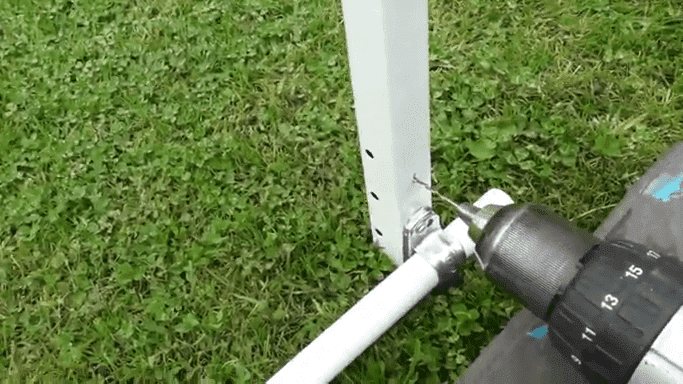Gazebos are lovely structures that provide a great outdoor space to enjoy with family and friends. But strong winds can come and spoil the fun. It can be scary when a gazebo is not secured, and the wind is blowing it away. This can cause damage to the gazebo and even harm people around it. Therefore, it’s important to know how to stop a gazebo from blowing away.
In this guide, we will share some tips and tricks to help you keep your gazebo in place, even during windy weather. We’ll start by assessing the risks and evaluating the gazebo’s sturdiness. Then we’ll explore different anchoring methods and help you choose the best one for your gazebo.
We’ll also guide you through the process of preparing the site and installing the anchors. Finally, we’ll show you how to secure the gazebo and make any necessary adjustments to ensure it stays in place. With our help, you can enjoy your gazebo without worrying about it blowing away.
How To Stop A Gazebo From Blowing Away: Keep your gazebo from becoming a hazard during strong winds by securing it properly. This guide provides step-by-step instructions on assessing the risk, choosing an anchoring method, preparing the site, installing the anchors, and securing the gazebo.
By taking these steps, you can ensure that your gazebo stays in place and that you can safely enjoy your outdoor space, even on windy days.
How To Keep Gazebo From Blowing Away Guide
If you have a gazebo and want to make sure it doesn’t get blown away by strong winds, there are a few things you can do. You can use weights like iron leg weights, and weights, or water weights, as well as pegs and ropes, anchoring kits, threaded rods, and polypropylene straps to secure it in place.
The surface where you set up your gazebo and the way you attach it are both important to prevent it from moving. It’s helpful to know what you can use to secure your gazebo, but it’s also important to understand how to use them properly.
The storm straps

One way to keep your gazebo secure is by using storm straps, also known as polypropylene straps. These straps can hold the whole structure down, even in strong winds. But you can only use them on a grass or soil surface because you have to use pegs to keep the straps in place.
If you have a permanent gazebo setup on wooden or cement floors, you can use rings to attach the straps instead. However, even with these straps, very strong winds can still damage your gazebo. So, it’s best to take it down if you know a storm is coming.
Rods with threads
If you want to keep your gazebo in one place for a long time, you can use threaded rods to attach it to the ground, especially if the ground is made of concrete. These rods are about 61 cm (24 inches) long, and you will need two per foot to make them very secure. Most gazebos already have holes in the feet, so you don’t need to drill new ones.
But if there aren’t any holes, you need to make them yourself. You also need to drill holes in the ground to secure the rods. If you don’t want to damage the floor, this method is not suitable.
Kits for anchoring
You can use anchoring kits to keep your gazebo safe from strong winds. Anchoring kits are more secure than pegs and ropes because the pegs are corkscrew-shaped, which makes them harder to be removed from the ground.
To secure the gazebo, screw four pegs into the ground for each corner and then feed the straps through the peg loops up to the horizontal bars in the inner roof of the gazebo.
Weights of gazebos
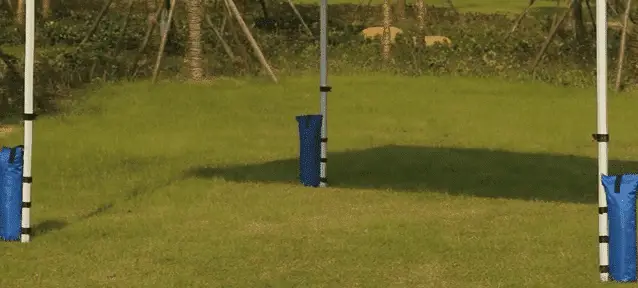
Gazebo leg weights are a great way to keep your gazebo from blowing away in strong winds. They can be used on any type of surface such as grass or concrete. You can choose from different designs such as cast-iron weights that slide over the feet of the gazebo legs, or sand and water-filled bags that clip onto the legs.
It is recommended to have 10-30 kg of weight per leg, or 40-100 kg in total, to make sure your gazebo is safely secured.
The bolts
If you want to secure your gazebo to a concrete patio, you can use bolts. You will need to drill holes in the concrete to attach the bolts. However, if you don’t want to damage the patio, this method may not be suitable for you.
To secure the gazebo properly, you will need one or two bolts per foot. Keep in mind that this method may not be the best if you will be taking down your gazebo often.
Why It’s Important to Secure Your Gazebo from Wind Damage?
It is important to keep gazebos from blowing away because they can cause damage to people, property, and themselves if they are not anchored properly. Gazebos can be large and heavy structures that can be lifted by strong winds and become dangerous projectiles.
They can also be expensive investments, and if they are not properly secured, they can be damaged or destroyed in severe weather conditions. Keeping gazebos from blowing away is important for safety reasons and to protect your investment.
The way a gazebo is made and the tools used to build it affect how well it stays in place. Different surfaces, like concrete or grass, also affect how well the gazebo stays put.
Selecting the Right Location
When selecting the right location for your gazebo, there are a few things to consider. First, you’ll want to think about the purpose of the gazebo. Will you use it for outdoor dining, relaxation, or as a focal point in your yard? Next, look for a location that’s both practical and visually appealing.
Consider the size of your gazebo, the terrain of your yard, and any nearby structures or landscaping. The position of your gazebo can affect the amount of shade it provides, as well as its aesthetic appeal. Finally, make sure to take into account any installation logistics, such as accessibility and proximity to utilities.
By carefully selecting the right location for your gazebo, you can create an attractive and functional outdoor space that you’ll enjoy for years to come.
Key Considerations for Choosing the Location of Your Gazebo
When you’re choosing a location for your gazebo, there are several important factors to consider. First, think about how you’ll use the gazebo. Will it be a space for outdoor dining, relaxation, or entertaining guests? The purpose of your gazebo will help determine the best location.
Next, consider the size of your gazebo and the surrounding area. You’ll want to make sure there’s enough space for your gazebo and any additional outdoor furniture or decor you plan to add. Additionally, consider the terrain of your yard and any nearby structures or landscaping that could impact the location of your gazebo.
Finally, think about any logistical concerns, such as accessibility and proximity to utilities. By carefully considering these factors, you can choose the perfect location for your gazebo and create an inviting outdoor space that you’ll enjoy for years to come.
The Importance of a Level and Stable Base for Your Gazebo
Having a level and stable base is essential for your gazebo’s safety and longevity. If your gazebo’s base is uneven or unstable, it can cause structural damage and even collapse during heavy winds or harsh weather conditions. A gazebo with an unstable base can also lead to safety hazards, such as tripping or falling.
Before installing your gazebo, make sure the ground is level and stable by removing any debris, filling in holes, and compacting the soil. You can also consider using a foundation, such as a concrete slab, to provide additional stability.
By ensuring a level and stable base, you can enjoy your gazebo for many years to come with peace of mind.
Anchoring Your Gazebo and Ensuring Safety and Stability
Anchoring your gazebo is an important step to ensure its safety and stability. Wind, rain, and other weather conditions can cause your gazebo to shift or even tip over if it’s not securely anchored.
Anchoring your gazebo helps to keep it firmly in place, preventing it from being damaged or causing any safety hazards. There are different types of anchors available, such as auger anchors, concrete anchors, and stake anchors, depending on your gazebo’s size and the type of ground you’ll be anchoring it to. Before anchoring your gazebo,
make sure the base is level and stable, and that the anchor is installed correctly. By properly anchoring your gazebo, you can enjoy your outdoor space with confidence, knowing that it’s safe and secure
Types of Anchors to Consider When Securing Your Gazebo
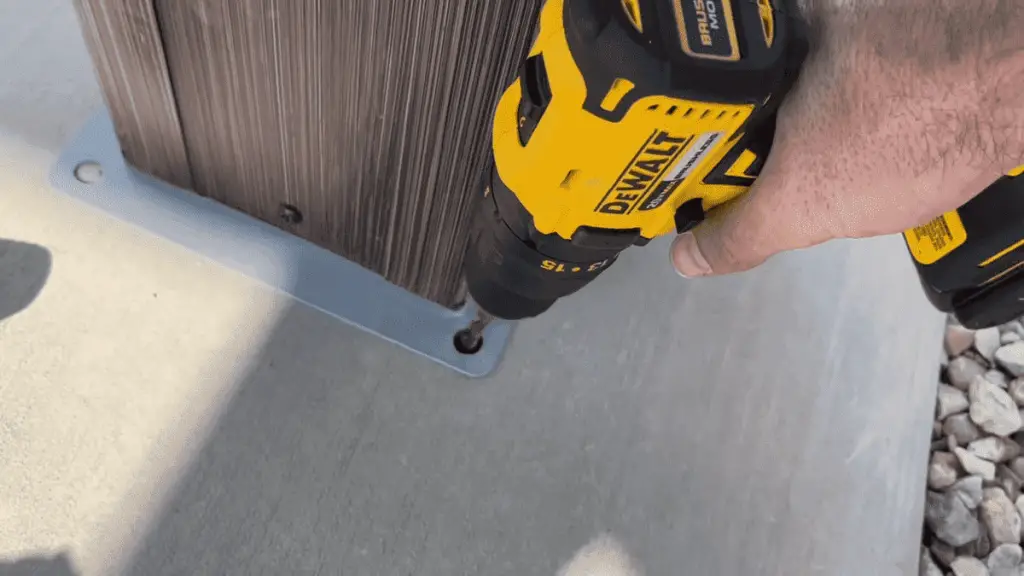
There are different kinds of anchors that you can use to secure your gazebo. Some examples include auger anchors, concrete anchors, and stake anchors.
The type of anchor you choose will depend on the size of your gazebo and the type of ground where you’ll be setting it up. Anchors are important because they keep your gazebo from moving or falling over, which can be dangerous.
Before you start anchoring your gazebo, make sure the ground is level and sturdy. And remember to follow the instructions carefully to make sure the anchor is installed correctly. By using the right anchor, you can enjoy your gazebo safely and with peace of mind.
Step-by-Step Guide for Installing Anchors on Your Gazebo
- Begin by selecting the appropriate anchor for your gazebo based on its size and the ground type.
- Position your gazebo in the desired location and ensure that the base is level and stable.
- Mark the position of each anchor on the ground using a marker or spray paint.
- Use a drill to create pilot holes for each anchor. The size of the pilot holes should match the size of the anchor.
- Insert the anchor into the pilot hole, ensuring that it is flush with the ground.
- If using auger anchors or stake anchors, use a wrench or hammer to screw them into the ground until they are firmly in place. If using concrete anchors, tighten the bolts until they are secure.
- Repeat steps 4-6 for each anchor.
- Check that all anchors are securely in place and that your gazebo is level and stable.
- Enjoy your gazebo safely and with peace of mind knowing it is securely anchored.
Tips for Ensuring Your Gazebo is Securely Anchored
- Choose the appropriate anchor based on your gazebo’s size and the ground type.
- Ensure that the base of your gazebo is level and stable before installing the anchors.
- Follow the instructions carefully to make sure that the anchors are installed correctly.
- Use a wrench or hammer to screw auger or stake anchors into the ground until they are firmly in place.
- For concrete anchors, make sure to tighten the bolts until they are secure.
- Check that all anchors are flush with the ground and that your gazebo is level and stable.
- Consider adding additional anchors if you live in an area with high wind or extreme weather conditions.
- Regularly inspect your gazebo and anchors to ensure that they are still securely in place.
- If you notice any signs of shifting or instability, reposition or reinforce your anchors as necessary.
- By following these tips, you can enjoy your gazebo safely and with peace of mind knowing that it is securely anchored.
Secure Your Gazebo with Added Weight
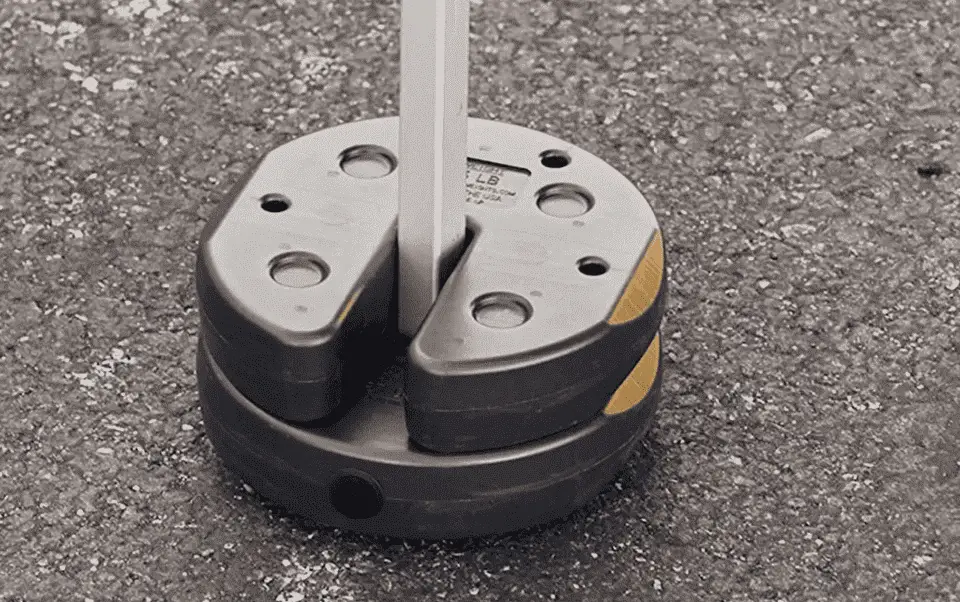
If you want to make sure your gazebo is even more secure, you can add weight to it. This will help to keep it from tipping over in strong winds or extreme weather conditions. You can add weight by placing heavy objects such as sandbags or concrete blocks around the base of your gazebo.
Make sure to distribute the weight evenly and secure the objects so that they don’t move around. By adding weight to your gazebo, you can have even greater peace of mind knowing that it is well-anchored and safe to use.
Various Options to Add Weight to Your Gazebo
There are different options for adding weight to your gazebo. You can use sandbags, concrete blocks, or heavy weights that are specifically designed for gazebos. You can also create your own weight bags by filling fabric bags with sand or gravel. It’s important to choose a weight that is appropriate for your gazebo’s size and weight.
Additionally, make sure to distribute the weight evenly and secure the objects so that they don’t move around. Adding weight to your gazebo can help to ensure its stability and safety in strong winds or extreme weather conditions.
Ensuring Even Weight Distribution for Your Gazebo
When adding weight to your gazebo, it’s important to distribute the weight evenly. This means placing the weights on all four sides of the gazebo so that it is balanced. If you only add weight to one or two sides,
it can cause the gazebo to tilt or become unstable. You can use a level to ensure that your gazebo is even and balanced.
Additionally, you can consider adding weight to the corners or legs of the gazebo, as this can help to provide extra stability. By distributing the weight evenly, you can help to ensure that your gazebo is safe and secure in all weather conditions.
Secure Your Gazebo with Added Weight
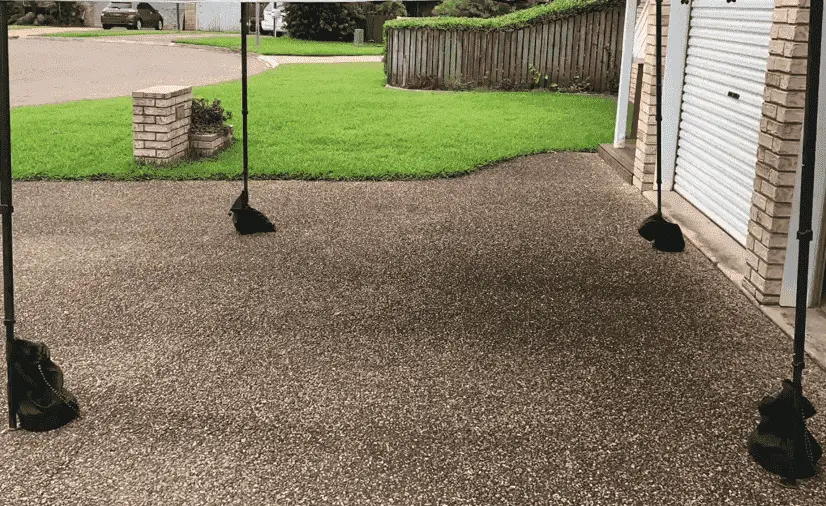
Here are some easy-to-follow steps for adding weight to your gazebo:
Get the appropriate weights:
Look for weights that are designed for outdoor use and are heavy enough to provide sufficient stability for your gazebo. You can use sandbags, concrete blocks, or specialized gazebo weights.
Determine the number of weights you need:
The number of weights you need will depend on the size and weight of your gazebo. As a general rule, you should aim to have one weight on each leg of your gazebo.
Place the weights on all four sides of the gazebo:
Distribute the weights evenly on all four sides of the gazebo. This will help to balance the gazebo and prevent it from tilting or becoming unstable.
Check the level of the gazebo:
Use a level to ensure that your gazebo is even and balanced. Adjust the placement of the weights as needed to achieve a level surface.
Secure the weights:
Once you have placed the weights in the desired locations, make sure to secure them tightly to prevent them from shifting or falling off during windy conditions.
By following these steps, you can add weight to your gazebo in a safe and effective way, ensuring that it remains stable and secure in all weather conditions.
Tips for cleaning and inspecting your gazebo
Here are some tips to clean and check your gazebo:
- Clean your gazebo regularly with a soft brush and soapy water.
- Rinse it well with a hose to remove any soap residue.
- Inspect the structure for any damage, such as cracks or rust.
- Check the roof for holes or tears.
- Make sure all bolts and screws are tight and secure.
- If you find any damage, repair it as soon as possible to prevent further damage.
- Consider applying a sealant to protect your gazebo from the elements.
FAQs
Q.1 How do you anchor a gazebo from the wind?
Temporary gazebos can’t handle winds stronger than 30 mph. If you want to prevent them from blowing away, you can use anchor pens and ropes to tie them down or use weights like sandbags to keep them in place.
Q.2 What is the best way to anchor a gazebo?
The most usual way to keep your gazebo in place is to use straps to hold the legs. You can tie the straps around the legs or use a ratchet to make them tight. If you tie the straps, make sure to tie them twice to keep them from getting loose. Another way to anchor your gazebo is to tie the straps to trees or posts near it.
Q.3 Is a gazebo better with sides on or off in wind?
Leaving the sides of a marquee off does not make it more wind-resistant. Actually, having the sides on helps to make it more wind-resistant. Many people mistakenly believe that leaving the sides off allows wind to pass through, but that’s not true.
Conclusion
The article provides detailed instructions and tips for preventing gazebos from blowing away, which is important for ensuring their safety and longevity. The first step is to choose a location that is level and stable, and then anchor the gazebo using various methods such as threaded rods, bolts, anchor kits, or gazebo leg weights.
Adding weight to the gazebo is also an effective way to prevent it from being blown away, and there are several options such as sandbags, water jugs, or concrete blocks.
Regular maintenance is crucial to ensure the stability of the gazebo, and the article recommends cleaning and inspecting the structure for damage, checking for loose bolts and screws, and repairing any damage as soon as possible.
In conclusion, following these steps will help keep your gazebo safe and secure in high winds, and ensure that it lasts for many years to come.
We hope you will be well aware of How To Keep Gazebo From Blowing Away reading this comprehensive guide. If you have any questions, feel free to drop a comment below

